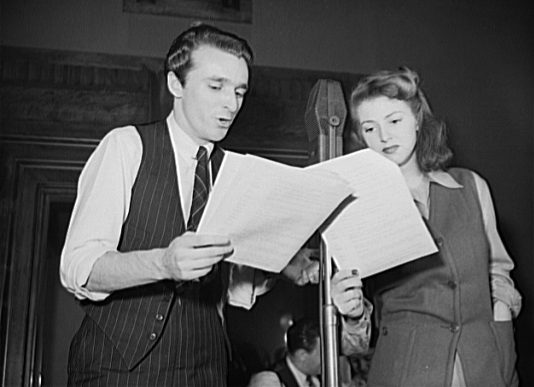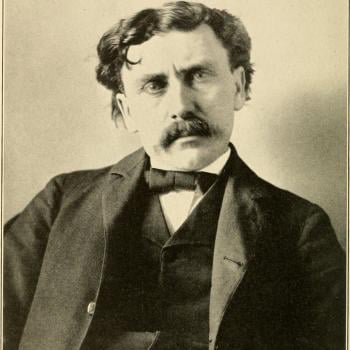Much of my work through the years has involved using popular culture as a vehicle for understanding American social attitudes, whether we are looking at religion and cults, or politics and race. This post is a comment on a major resource there that we perhaps tend to forget. That comment might be unfair, in the sense that this resource might be really well known to others, but I hope some might find this useful. In short – we all know about books, magazines, films, and television – but what about radio?
My current book project is a history of the genre of folk horror, which uses the idea that potent ancient forces and deep-rooted evils survive in the landscape, scarcely acknowledged by the modern world. In isolated communities, active witches or pagan groups seek to mobilize those dark forces, deploying rituals dating from pre-Christian times. I trace this idea from its beginnings in the 1880s to the explosion of fictional works around 1970, and seminal productions such as The Wicker Man. Then, in recent times, we move to productions like Midsommar. This is a big field of study these days, which is heavily slanted towards films, although with some recognition of literary horror – novels, short stories, and pulps. I am certainly following in those footsteps, and doing my very best to avoid what we might call cinematic imperialism, the near-exclusive focus on films because they are so easy to research.
My main present goal is to emphasize the US contribution to the genre, which usually gets short shrift in a British-dominated field. I can point to lots of American stories and novels that fit the description perfectly, including the very well known writings of H. P. Lovecraft, as in “The Dunwich Horror.” There is a huge amount in legendary pulp magazines like Weird Tales. But I am finding very little in the way of films, largely I think because of the workings of the Hollywood Production Code, the censorship system that came into draconian effect in 1934. I find a couple of important B pictures, but nothing major. Hmm, where is folk horror in popular culture?
But if cinema did not allow folk horror treatments, other popular media were far more welcoming. There is certainly some important television in the late 1950s and early 1960s, including one 1961 item that I have studied, and which I think may have been the first ever folk horror production in the visual arts, namely the 1961 Thriller episode entitled “Hay-fork and Bill-hook”. This concerned a gruesome (true life) witch-murder in an English village.
But television is only a small part of the story. Between the 1920s and 1950s, the United States had an incredibly lively radio culture of music, news, sports, comedy, serials, soaps, drama, Westerns, and romance, which reached impressive mass audiences, literally in the multi-millions. In terms of drama, by far the most famous product of this era was Orson Welles’s 1939 broadcast of The War of the Worlds, but this was only the tip of a sizable iceberg. When ordinary people were not going out to the movies, they stayed at home and listened to radio. This was no niche market, and any major commercial firm that cared about its revenues directed its advertising budgets accordingly. And of course, politicians knew the vital significance of this market. Think of the radio priest, Charles Coughlin, and Franklin Roosevelt owed much of his popularity as president to his skills in radio presentation. In terms of broadcast standards, this was in no sense a libertarian environment for creators, but it operated differently in crucial respects from the Hays Code in the cinema.
I mentioned that I am studying horror and suspense fiction, so what can I find in these radio resources? Actually, a vast amount. The pioneering anthology series of The Witch’s Tale (1931) and Lights Out (1934) were followed in 1940 by CBS’s hugely popular Suspense, which offered free-standing productions that fitted that very general title. Many of these, in fact, were horror items, with such titles as The Lord of the Witch Doctors and Will You Make a Bet with Death? Over nine hundred shows – nine hundred! – appeared over the 22 year run of that Suspense series, many featuring the leading stars of the day. Mutual Broadcasting had its much-praised horror/suspense series Quiet, Please! and The Mysterious Traveler.
Different kinds of media also intertwined and cross-pollinated in surprising ways. Actors moved easily between the worlds of stage, screen, and radio. Lots of Hollywood films used the world of radio as the setting for stories, whether comedy, romance, or drama. Also, plenty of radio serials migrated to become serials in the movie theater, and a few (like the Lone Ranger) went on to become mainstays of early television. The chilling horror/suspense series Inner Sanctum (1941-1952) led to several movie spinoffs, and eventually a television show. By the way, that original Inner Sanctum radio series itself ran to 526 episodes.
And don’t forget comics. The wicked witch of the radio series The Witch’s Tale evolved into the Old Witch who hosted those notoriously bloody EC comics in the 1940s and 1950s. Superman began as a comic, and always remained so, but from 1940 through 1951 it was also a very popular radio series. Then it became a television show, and in 1978, a movie franchise. The Mysterious Traveler became a pulp magazine.
In the case of horror, the sheer volume of output meant that the producers were always in search of useful material, and they had a near-symbiotic relationship with the pulps. In 1932, The Witch’s Tale dramatized the famous confessions of Scottish witch Isobel Gowdie. In 1945, the very high-profile actor Ronald Colman starred in a Suspense production of Lovecraft’s The Dunwich Horror, which I have described as that author’s most explicit venture into folk horror.
All these shows presented horror that would have been unacceptable in Hollywood. In 1951, NBC Presents had a dramatized adaptation of Shirley Jackson’s “The Lottery,” which would not appear in cinematic form for another two decades.
I make one point which should be obvious. Many scholars rightly point to film noir as one of the great cultural products of mid-century America. But would those famous films have found anything like the market they did if the radio shows had not spent the previous couple of decades creating and expanding a vast national audience passionately interested in horror, crime, and suspense? Cinema did not and could not stand alone.
That anthology format survived near-intact through the 1950s, as the American networks made their transition from radio to television. NBC, CBS, and ABC all originated as radio broadcasters, the first two in 1926-1927, with ABC in 1943. Mutual (1934) represented the other member of what was then the Big Four, although it remained mainly concentrated in radio even after the TV revolution.
One early suspense/horror manifestation on television was Cameo Theater, which offered its televised dramatization of “The Lottery.” The best known of these new anthology series achieved visibility by using a celebrity presenter who appeared at the beginning of each episode. Alfred Hitchcock Presents proved very popular, and Rod Serling’s Twilight Zone dates from 1959. That model was imitated by Boris Karloff’s Thriller, which hosted “Hay-Fork and Bill-Hook” in 1961. And that was by no means the only continuity from the themes of the old pulps. Just in its first two series, Thriller presented eighteen episodes drawn directly from stories that had first appeared in Weird Tales, including work by Robert Bloch, Henry Kuttner, and August Derleth. One of the show’s most highly regarded episodes was an adaptation of Robert E. Howard’s “Pigeons From Hell,” which often shows up on lists of the very best horror/Gothic stories of all time.
If we are seeking media treatments of witches, cults, and haunted landscapes in this era, and of folk horror more generally, then we need to look first at radio, and then to the television industry that was its heir. And every word of what I say there applies to whatever other topics we might be researching in that long and vital period of American history. The amount of potential material for studying (say) gender, race or ethnicity is limitless. Oh, and if you want to know why early American television looked and acted like it did, never forget that they are basically just shifting over from their several decades of experience in radio. Yet for many of us, radio remains a whole missing dimension of social and cultural history.
Go thou, and listen.














